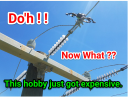If that noise comes from any kind electric discharge, that creates some kind pulse of RFI.I will say that on some days there is an audible "snapping" noise that comes from the power lines. I have never flown on a day that was happening. I once called the electric company thinking that the noise indicated a problem, and they said it is not unusual when the humidity is high and nothing to worry about. But I imagine the snapping might indicate some some RF noise.
Which certainly never helps in controlling drone.
And besides at least some level magnetic field from current, ferrous metals themselves cause disturbances in Earth's magnetic field, so big steel structures are extra risk factor.
(that magnetic anomaly is one way to find submerged submarines from air)
So while it isn't necessarily to automatically stay far way, it's best to have respect for power lines.
Meaning instead of directly flying in middle of them at close proximity/close above, start from some distance away and observe if there are any issues/symptoms











